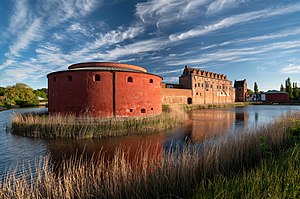Annual Report 2022/Fail fest: Downward trend in Wiki Loves Monuments
In this story, we focus on the trends and development of Wiki Loves Monuments. The competition has been going on for thirteen years, growing into the world's largest photo competition. Despite this development, the participation in Sweden is somewhat declining. This is an opportunity to search for new collaborations, invite more people to photo safaris and encourage more planned gatherings.

Last year's Wiki Loves Monuments was the 13th in a row. The first year it ran, only the Netherlands participated; Sweden is one of the five countries that have participated every year since then. The photo competition, aiming to document and showcase protected cultural heritage objects, is run by volunteers in partnership with agencies responsible for providing the basic data. The photographers, both new and old, take pictures of the objects on the lists. The competition opens up for both new partners who contribute data and new photo communities who are offered a new arena to show off their work.
The year we ran the competition for the fist time, we did it in partnership with the Swedish National Heritage Board. We focused on listed buildings and archaeological monuments as potential photo topics. Over the year, the number of objects to photographs has expanded. We now count ArbetSam and the Maritime Museum in Stockholm among our partners and have included working life museums as well as culturally significant ships and pleasure boat in the competition.
Data from our partners has been made available in several batches, first in the so-called WLM database, and later also on Wikidata. It was done in order to be able to assemble good lists and build map tools and upload processes so that the photographers can easily find photo topics, and so that the uploads can be done more simply. The documentation and procedures for the competition are continuously improved each year, and the competition entries are used in articles and re-used by partners if they lack their own photos.
Enriching the photos with Structured Data on Commons (SDC) and linking them to Wikidata, that is adding the unique database identifiers of the photographed objects to the metadata of the images, makes the material easier to find, for example if one wants to illustrate a Wikipedia article. We are also helping other countries that participate in WLM to work with their data and links. These links make it possible for us to learn which objects are being photographed (or not!), and they also make it easier for our partners who might want to find and re-use photos in their own systems.

While the competition has had such positive results, there's some problems we have to handle. Since the first year, there's been a declining trend in both the number of participants and new photos. The involvement of the community is also declining if you ignore the few participants who return year after year. The media visibility is low, apart from some news outlets who pick up local winning entries that go out into the world to compete in the international finals. Speaking of the international finals, it has also been a long time since a photo from Sweden made an impression on the international jury, despite the entries both showing a high level of technical skills and being aesthetically pleasing.
In order to turn the trend upwards again, looking at both engagement and participation, we should take advantage of what has worked so far and build on this. This year, events that nicely align with our other project Wikipedia for all of Sweden include, for example, photo safaris with local photography clubs where we can be visible, meeting volunteers and WMSE members. In particular if we combine them by contacting local attractions in advance so that we can get access to and photograph places where the general public normally cannot enter. We also believe that active communication with local press outlets ahead of the events could make a difference. The visibility of the competition outside of our usual target groups can be improved by better social media posts where a new communications officer (or a dedicated communication volunteer found via Volontärbyrån) shares images and adapts the communication to reach more people via our partners' channels.
Many objects that are easy to photograph already have many good photos. This means that if we re-introduce an award for the best photo series of one object, as well as an award for the best picture of an object with no previous photo, it could lead to increased interest. Another idea – albeit requiring an extra year before we can implement it – is to introduce an award for the best yearly documentation: photos of the same object in spring, summer, fall and winter.

